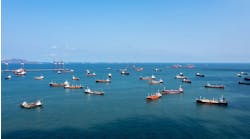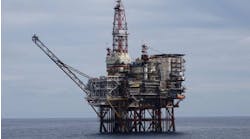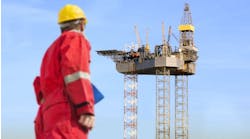Venture to expand oil exports in GKA area
Venture Production plans to overhaul the oil export system from its Greater Kittiwake Area (GKA) fields in the central North Sea. This will involve replacing the tanker offloading arrangement - in place since the start of production in 1990 - with a new 33-km (20.5-mi), 10-in. (254-mm) pipeline between the Kittiwake platform and BP’s Forties Unity riser platform. From there, GKA crude will pass through the Forties Pipeline System.
Since 2003, when Venture and its partner Dana Petroleum became co-owners of the GKA complex, they steadily have raised throughput from 5,000 boe/d to over 30,000 boe/d, via a $322.7 million (£170 million) program of rehabilitation work and subsea tiebacks. The oil export system implemented by previous operator Shell Expro comprises a dedicated storage and shuttle tanker, but this will reach the end of its working life late next year.
By that point, Venture hopes to have the new line operational - Subsea 7 is contracted for pipelay and associated tie-ins during 2Q 2007. The new arrangement should also lessen the production downtime that occurs currently when the tanker is unloading or has to be taken off-station due to bad weather.
The estimated construction cost is $123-$132 million (£65-70 million) GKA duty-holder Petrofac will manage topsides upgrades on the Kittiwake platform, with Wood Group performing a similar role on Unity. Venture and Arclight Energy Partners Fund III will co-own the new line, which will have spare capacity for future tie-ins of fields operated by Venture and also by third parties. Some of these could be connected directly to the Kittiwake topsides facilities.
Venture has near-term drilling plans for four oilfields in the general area, Grouse, Christian, and the prematurely decommissioned Durward/Dauntless. All could feed through the new line by end-2008. BP also sees the project opening up new business opportunities for the Forties system.
Double-strike in Alwyn area
Total has made two further discoveries in the Alwyn Area in the Northern UK North Sea. The Jura West 3/15-10 well, drilled 10 km (6.2 mi) east of the Dunbar field, intersected over 300 m (984 ft) of gas-bearing Mid-Jurassic Brent reservoir. Total aims to bring this find onstream in 2008 via a 3-km (1.8-mi) tieback to the Forvie North subsea manifold, which is connected to the Alwyn North NAB process platform. The company is also lining up a further exploratory well nearby.
Another well drilled from the Alwyn North NAA platform (3/9a-N50) encountered gas condensate and oil-bearing sands in the Statfjord and overlying Brent formations. Other near-field UK drilling successes in recent weeks include Silverstone’s 150-200 bcf discovery Vulcan East in the southern gas basin - likely to be produced via ConocoPhillips’ V-fields infrastructure.
Energy Development Partners has also struck a deal with Shell and ExxonMobil to develop the stranded Barnacle field early next year, through an extended reach well from the Brent D platform.
Grove re-visits Horizon West
Canadian independent Grove Energy has gained a foothold in the Dutch sector, securing a production license for block P8a, which includes the undeveloped Horizon West accumulation. Mobil discovered this structure in 1982 via three vertical wells, which tested oil at rates of up to 900 b/d. The field lies within Lower Cretaceous Vlieland sandstones at a depth of around 1,800 m (5,905 ft), in 33 m (108 ft) of water.
In-place reserves are estimated at 50-70 MMbbl, but historical data suggests recovery potential of only 8-12%. Grove, however, plans to expose a larger section of the reservoir by drilling a horizontal extended reach well from Chevron’s P9 Horizon platform, 6 km (3.7 mi) to the east. The two parties are currently negotiating processing and export options.
Grove also picked up three Dutch offshore exploration licenses covering a total area of 1,148 sq km (443 sq mi). F14, F18, and L16 house three Jurassic oil discoveries from wells drilled during the 1970s and 1980s, with flow rates ranging from 500 to 2,775 b/d. Grove will conduct a geological and geophysical study of the acreage, and plans to reassess existing 2D and 3D data-sets and reservoir simulation models. It will then drill new appraisal wells and, where merited, test for deeper-lying gas.
Total also gained a new Dutch exploration license, L3, 100 km (62 mi) north of Den Helder, which covers an area of 406 sq km (157 sq mi). Total will likely farm out 40% of the four-year permit to Dutch state company EBN. L3 is close to Total-operated production in blocks L4a, L7 and F15a.
CO2 storage under review
A joint industry/academic team is to investigate the potential for carbon capture and storage from Norway’s Sleipner and Snohvit fields. Both will undergo carbon dioxide injection trials, as will the onshore In Salah field in the Algerian southern Sahara.
The main aims of the CO2ReMoVe project are to assess the reliability of geological storage of CO2, and to establish scientifically-based standards for monitoring future storage/capture operations. The TNO R&D institute in The Netherlands will coordinate the program, which will bring together researchers from various European academic institutions. Oil companies sponsoring the project include BP, ConocoPhillips, ExxonMobil, Statoil, Total, and Wintershall, with the European Commission providing further funds.
Although the oil and gas industry has applied CO2 injection for enhanced recovery purposes, the techniques are costly, and need further refinement as a tool for limiting greenhouse gas emissions. The study team will try numerous approaches to monitoring/verification at the selected sites, including electromagnetic testing, fluid sampling, soil testing, and 3D seismic acquisition. Work should be completed by mid-2011.
Under a separate initiative, seven Norwegian research groups are investigating the feasibility of a land-based laboratory for studies of CO2 behavior during storage in bedrock. Gasnova, Norway’s national gas power technology center, has awarded the consortium $310,000 (NOK 2 million) to estimate the likely cost of such a scheme, and to identify a suitable onshore site, where scientists could inject and store CO2 safely in sedimentary rock.
Jeremy Beckman, London




